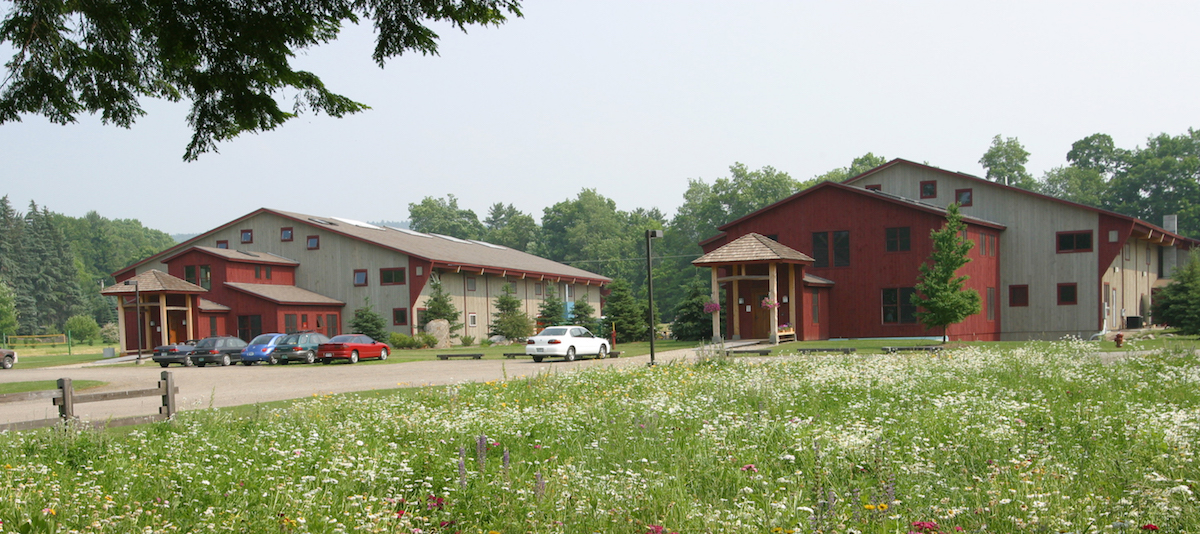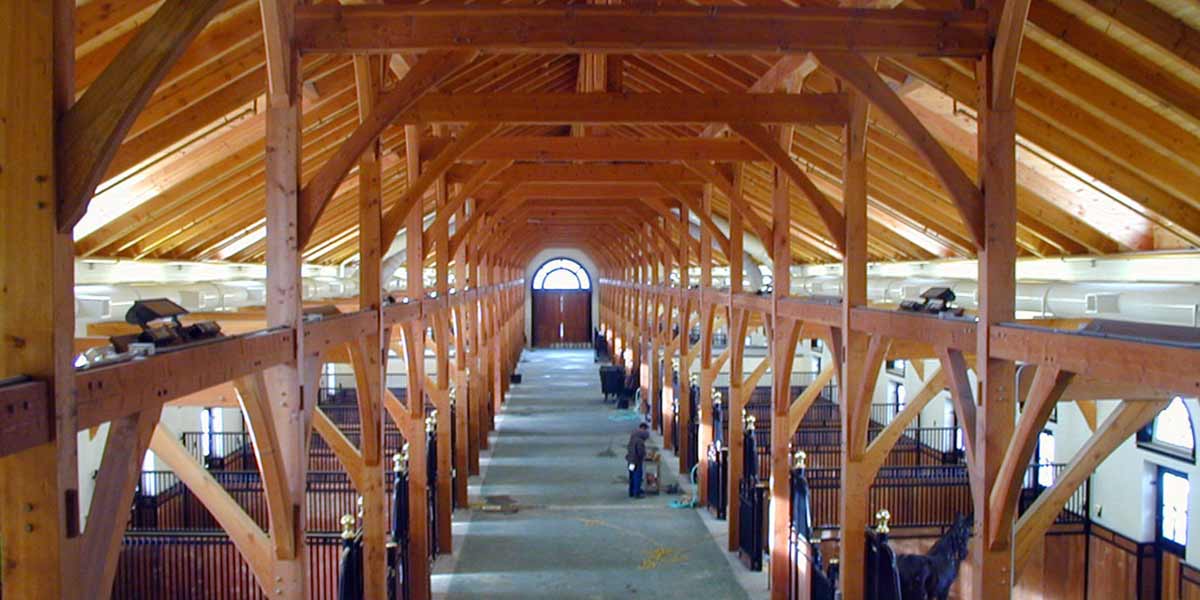Like many entrepreneurs, Tedd Benson says he founded his company almost “inadvertently.” After being hired for a string of freelance building jobs in the early 1970s, Benson opened up his own shop with few resources and a big dream: to revitalize timber framing — a bygone building technique used to fashion historic homes and structures in the mid 19th century.
More than 40 years later, Bensonwood is known across the country for high-quality construction, sustainable design, and a winning workplace culture Benson calls “servant leadership.”
As a coach of executives, teams, and organizational culture, my radar is up for companies that seem to have excellence in these facets of business. I first learned of Bensonwood when I ran into one of the firm’s employees at a gym. He raved about the culture, how cool his job was, and how much he liked his coworkers. I then had a chance to meet founder Tedd Benson at the ribbon-cutting ceremony of a local bank his team constructed in Keene, NH, and I arranged to pay a visit to the company’s headquarters in nearby Walpole to learn more about how he created the culture he has today.
Upon arrival a few months later, I was struck by the beauty of the symmetrical red buildings that make up Bensonwood’s headquarters — most of which are constructed from salvaged wood. Like many manufacturing companies, Bensonwood focuses on “lean” manufacturing principles, a concept pioneered by Toyota to eliminate waste and inefficiency. Yet the proverbial “us versus them” or “shop versus office” dichotomy didn’t seem to exist. Employees were warm, energetic, and eager to show me what they were doing.
But the company’s journey was not always a smooth one. Despite his best efforts, Benson admits that during his early days in business, he was “not a good leader.” The path he chose and the lessons he learned can teach business leaders a great deal about overcoming adversity, rethinking preconceived notions, and building a stronger company that works for everyone.
I sat down with Benson to learn more about stewarding a successful company culture and the intangibles that make up a happy workplace.
How do you define culture at Bensonwood?

Tedd Benson, founder of Bensonwood.
Tedd Benson: It all boils down to servant leader culture — serving others as opposed to leading or managing them. I believe deeply in this concept, and it has to come from a place of authenticity. It’s about recognizing that the people around you have potential that needs to be tapped, and tapping that potential is an engendering process — not a pulling or pushing process.
Your peers often have more potential than they know and certainly more potential than you know, and the idea is: How can we get those best selves to rise? Team members who work as their best selves have a sense of ownership and a real authority to manage what’s in front of them. That is what’s the most empowering. But the process of getting there is often hard to define, because it’s different than managing or coaching. It may include all of that, but it’s also much more.
Think of your role as a parent: You want your child to feel loved, and your child will not feel loved just because you said, “I love you.” They will not rise to their best selves because you said, “I believe in you.” There’s something more, and that something more is completely intangible. It’s bigger, it’s harder to reach, but it’s what makes us alive and at our best.
How did this come about? Was a focus on community and culture always part of your company?
TB: In 1973, once I realized I was in business and chose to be in business, I decided I wanted to revive timber framing in North America. Historic buildings like churches and town halls are a defining attribute of our area of New Hampshire and towns like Walpole, Keene, and Westmoreland. And every one of those buildings is timber framed. If it was built before 1870, it’s a timber frame.
And I thought: “Wow, these buildings are still loved. They’re still worthy of repair and renovation. They’re defining of a culture. Why did we drop it?” Apparently we dropped it because it was inefficient, impractical, and required too many skills. So as a young guy, I said: “Well it’s the 20th century. We can apply some new tools and technology to it and maybe make it practical.”
That decision came with some naïve and idealistic notions, and really it was a bit unrealistic. But it became this passionate thing that I grabbed onto, because I liked building but I didn’t like the conventional building process — and a lot of that comes back to culture.
Can you describe the challenges in conventional building culture and how you hoped to address them?
TB: The building culture can be pretty lowbrow. It’s kind of a lowest common denominator of attitude and intention. I found that really unfortunate and wanted to develop a better building system that demands more of practitioners: more skills, higher attitudes, better craftsmanship.
It’s beneficial to homeowners to have a better built building and better for the practitioners to have a higher art form as a part of their lives.
I didn’t know better, so I reached for the stars, but it worked. We built our first timber frame in 1975, and according to the Concord Monitor it was the first one built in 80 years. From 1975 to 1979, we were timber framers. That first house led to another one and then another.
But I realized that if my dream was going to come true, we needed more than our little business in southwest New Hampshire. We needed an industry. We needed more practitioners. So I wrote a book called “Building the Timber Frame House,” which came out in 1979. It was an invitation that really worked. It came out and lots of people read it. They still read it, and it became a seminal work in the industry.
Reviving timber framing in North America became my obsession: teaching it, learning it, and digging deep into it. I wrote another book in 1984, taking it further, and I was on all cylinders. There was a team growing around me, but I was not a good leader. I was a passionate one. I was benign, I meant well, but I didn’t draw the best out of my team. I was so driven that I wasn’t paying attention to those around me.
How did you learn to be a better leader, and how did this shape Bensonwood’s culture as it is today?
TB: One day in 1988, I was waiting early in the morning for a few guys to come in. They were late to work, and I was mad. I was stewing about it, figuring out what I was going to say and how I was going to say it. But when the first guy stumbled through the door 20 minutes late, I didn’t say anything. Something hit me right then. I knew he did not want to be there.
We were doing amazing stuff, but the people I was doing it with — people I’d come to know like brothers — were not engaged. I realized that somehow my energy, my pace, and my attention to them was not in the right place. Within a day, I gathered everyone together and said: “Something is wrong here. I don’t know what it is. We’re doing great work, but I can see there’s really low morale. I think there’s a problem, and it may be me. I need to get away.”
So, with less than two days notice, I took a sabbatical. I relinquished my clients and projects and said: “Here’s an opportunity for you. You guys take it.” I knew my team had the skills as designers, timber framers, and woodworkers, but I didn’t know how it was going to work out. The only thing I knew is that I didn’t want to spend my time ruining other people’s lives.
The funny part is that at the time my house was only about 200 yards from the shop, but I walked up there and did not come back. I didn’t set foot in that shop for months.

Bensonwood employees work on a project in the shop.
What did you do during your sabbatical, and how did it shape you as a leader?
TB: I read like crazy — about leadership and about all kinds of things. That journey led to Peter Senge, Margaret Wheatley, and W. Edwards Deming. I also focused a lot on David Bohm and his work around dialogue and self-awareness. Bohm examined the idea of complex systems and how organizations are actually organisms. That’s where many of these ideas around engendering life instead of enforcing life became obvious to me, and it wasn’t long before I felt like I had a better sense of what I was doing wrong.
I was not using the collective intelligence of my organization well, which meant I was missing something. I was working too hard. It all had to come from me.
I was getting used up, and my team wasn’t being used well enough.
When I came back, I basically said: “For all of this time, you’ve been doing my bidding. You’ve done what I wanted. And now what I want is to do what we want to do. But we have to find out what that is.” I brought in a facilitator, who helped us pull out voices and ideas and develop a methodology for the future.
What did this rebuilding process teach you about creating a collective company culture?

Bensonwood headquarters in Walpole, New Hampshire.
TB: Some of it started with learning how to dialogue. We didn’t know how to communicate as a group, so we had to learn some fundamentals right then. We began with a big cork board, where our facilitator Robert had us writing ideas about what the company needed or directions it should go. The ideas went up on red slips of paper and, as we reached consensus, they moved from yellow and then to green.
The process took a long time — we worked on this for four years beginning in 1988 — but we were making visible progress. When we had the energy, we’d tackle something new. Reaching collective consensus about mission, vision, and goals helped us to become a different kind of company. The company became ours, not just mine.
And you now call that a servant leader culture?
TB: Yes, and it’s a servant leader culture for everyone. Wherever you are in the company, there are people around you who need that servant leadership. It’s not just me to my team members. It’s everybody to each other. Even our peer evaluations now focus on the concept of leaders creating more leaders — and we never have enough.
If we have 108 people here, we need 108 leaders.
In this, there’s something else that’s really important. Creating more leaders not only makes us a stronger company, but it also makes us more efficient. Our more high-level or experienced employees are not there to manage other people. We are trying to put the tools together for people to manage themselves, because they are capable of doing that. Almost everybody here is managing a family, so they can also manage themselves at work.
If your team needs oversight, that’s not a good thing — and it’s likely a process problem, not a human problem: They’re not capable, they’re not motivated, or they don’t care. It’s on us — and every company — to fix our process and do better in that respect.
Beyond rethinking the traditional management structure, what else makes up the servant leader culture?
TB: It’s totally dependent on authenticity. If I don’t really care about you, I can’t fake it. Likewise, if your company culture is not authentic, you can’t do a thing. But if your team feels that you viscerally care about them — not just the job, but about them — that overrides everything and creates space for forgiveness. You can mess up a little bit as you figure things out.
To take it the other way, there are also tools and techniques that are really important for us to operate a business. We have, like a lot of businesses, glommed onto lean thinking and lean methodologies — partially because it puts the power closest to the action. It authenticates what we’re trying to achieve and puts it into a process that can be defined.
Do you have any closing advice for other business leaders about engendering this type of shared power?
TB: One of the most useful tools for any business leader is humility, and there isn’t enough of it. If you think you know it, you probably don’t. If you think you are in charge of it, you probably aren’t. Humility, in almost any profession or anything that we’re doing, will make the world a better place.





